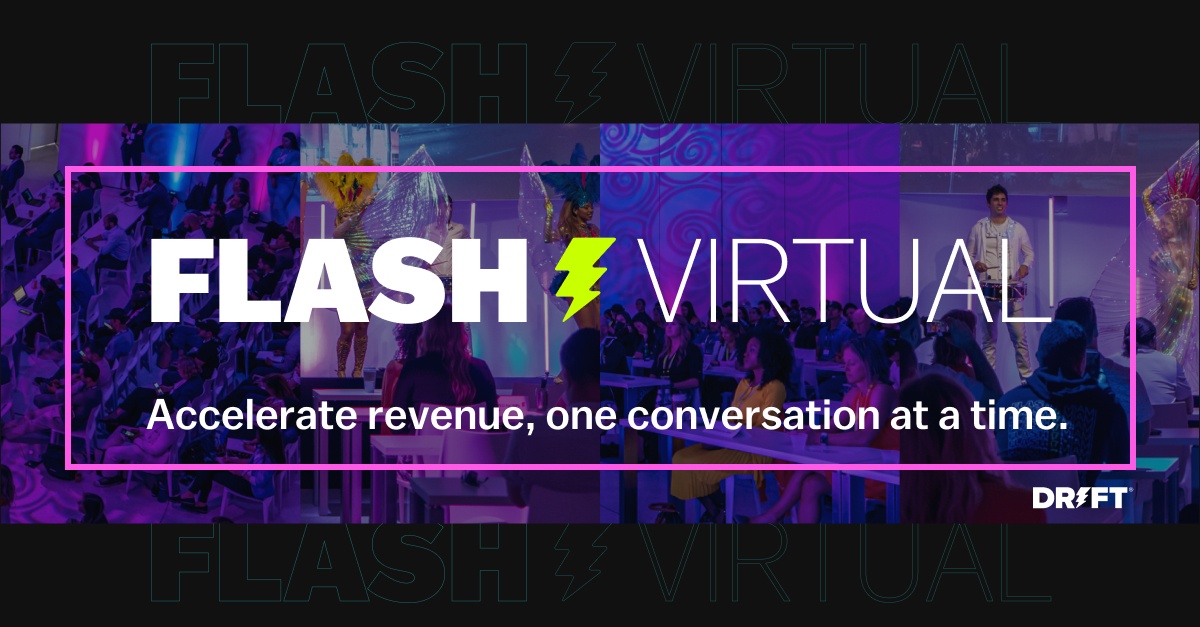Lead generation is always top of mind for marketers. After all, if you don’t have enough leads in your funnel, there’s no way that you’ll meet your goals for conversion — or revenue.
But lead generation is a challenge.
You may end up driving hundreds of low-quality leads that your sales team ends up having to sift through or pay so much for high-quality leads that you don’t earn a high enough return from new customers.
That’s why, in this guide, we dive into the types of leads that are right for your business, the lead generation process, and the most effective lead generation strategies.
What is a Lead?
A lead is a person who has expressed some form of interest in your product or service and has high potential to become a customer. This person may have responded positively to a cold email, signed up for one of your webinars, or used a free version of your software.
The term “lead” is frequently used by businesses with more complex buying processes than B2C purchases, so it describes people who may take weeks, months, or even years to become a customer. That’s why it’s used most often by B2B businesses, professional services companies, and home service providers.
Every company has their own way of qualifying leads. And this tends to change over time — for example, as a business grows, sales teams may update their lead qualifications to target more enterprise companies or include more industries.
Most companies use one of these frameworks to qualify their leads:
Marketing Qualified Leads
A marketing qualified lead (MQL) has engaged with marketing materials and is deemed by marketing to be qualified enough to pass on to the sales team. For example, they may have downloaded an ebook and marked the appropriate selections in the lead form, such as being in the right industry or having the right job title.
MQLs can vary in their readiness to buy, all the way from not-quite-ready to desparate for a solution. The materials they engaged with will give some hints.
Unfortunately, the MQL framework is likely to lead to a lack of sales and marketing alignment. With marketing potentially handing over a high volume of unqualified leads, sales teams may end up having to do a lot of manual work, wasting precious selling time.
In addition, the MQL process has many steps — and, as a result, it can take days for someone who becomes a lead to actually get to talk to sales.
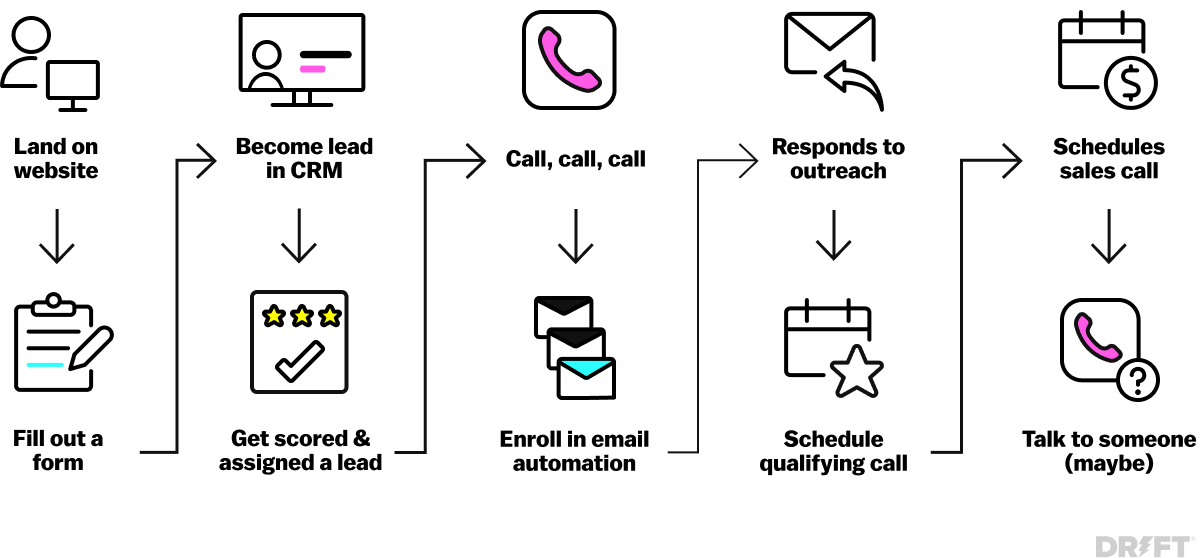
Our book, The MQL is Dead, dives deeper into why the MQL concept is outdated and what sales reps really care about. (Hint: It’s accounts.)

Sales Qualified Leads
A sales qualified lead (SQL) is someone who meets the sales team criteria, and is usually ready to buy or at least ready to explore their options. They may have come from marketing as an MQL, having then checked enough boxes to be considered an SQL. Or, the lead could have been employed at a target account, and they responded to an outbound sales play like a cold call or cold email.
Conversation Qualified Lead
A Conversation Qualified Lead (CQL) has expressed interest in buying your solution by chatting with a chatbot or a conversational marketer.
With Drift, you can automatically qualify CQLs with your own custom criteria and then route the appropriate leads to your sales team right away. Or, if they’re not quite qualified, you can train your chatbot to helpfully answer their questions with chatbot sequences, AI, and ready-to-go resources.
Product Qualified Leads
A product qualified lead (PQL) is someone who has taken enough action inside of a platform or app to show their interest in upgrading to a higher subscription tier. Product-led growth companies usually offer free access to their platforms in order to collect as many PQLs as possible.
Growth managers often test PQL criteria to improve sales effectiveness. For example, within an accounting software, the PQL criteria might be a user sending an invoice. But if the leads they are getting aren’t as high-quality as expected, the criteria could be changed to include sending an invoice and integrating a bank account — actions that show a higher intention of using the product long-term.
Customer Service Qualified Leads
Many modern websites feature live chat to cater to customers’ and potential customers’ needs in real time. A customer service qualified lead has interacted with customer support in order to ask a sales-focused question. Or, they may have asked explicitly to get in touch with sales.
Other Types of Leads
You may have heard of other types of leads, like hot leads or enriched leads. These are essentially adjectives describing leads, whereas the types listed above are frameworks for determining leads.
Here are some other common terms used to describe leads:
- Hot vs. Cold Leads: The “temperature” of a lead refers to the person’s interest level. A hot lead is dying to talk to you and can’t wait for the upcoming sales conversation. They respond quickly to emails, ask lots of questions, and are working hard to get your solution approved by their internal decision-makers. A cold lead has stopped responding altogether — and a warm lead is somewhere in the middle.
- Enriched vs. Non-Enriched Leads: Enrichment means that additional information has been gathered for a lead. You may have very sparse data on a non-enriched lead, such as the person’s name, role, and company name. To enrich a lead, a salesperson needs to research the company and individual as much as they can to add relevant data, such as funding information, company headcount, etc.
- Inbound vs. Outbound Leads: Inbound leads come through strategies that attract leads like blogs and email newsletters. Outbound leads are generated via outreach-style strategies like cold emails and cold calling.
What Is Lead Generation?
Lead generation is the process of acquiring new leads for a business to nurture and convert them into a customer.
Businesses will use a variety of methods to generate leads, including content marketing, paid advertising, sponsoring or hosting conferences, and cold calling.
Once leads are acquired, you need to work to create more interest for the solution on offer, build rapport with leads, and drive them towards a closed deal. Here, it’s smart to utilize technology to both automate nurturing and track all one-to-one activities required to close.
Why Is Lead Generation Important?
91% of marketers rank lead generation as their most important goal and most marketers spend over half of their budget on lead generation.
That’s because lead generation is critical for filling up the sales team’s pipeline with high-quality leads. Without high-quality leads, your sales team won’t be able to meet their quotas or generate the revenue that keeps the entire business afloat.
With the right lead generation strategies, you can reach potential customers at a variety of awareness levels and buying phases — so you can be a helpful resource no matter the lead’s questions or concerns.
Take solar installation, for example. Homeowners and commercial property managers who are interested in solar may take months or even years to move forward with an installation plan. They have to spend time researching different solutions, speaking with their spouse or client to set the budget, and planning ahead for the best installation date.
To be successful, solar companies need to generate leads at a variety of awareness levels (considering solar as an option, comparing companies, preparing to invest, etc.). Otherwise, they’ll miss the opportunity to walk potential customers through the decision-making process and lose customers to competitors who can assist them better.
The Lead Generation Process
The majority of leads who come to your website aren’t ready to buy. So, attracting leads is only the beginning — lead nurturing is where most of your results will be realized.
All in all, there are six main stages in the lead generation process.
1. Attract
The first step is to attract visitors to your website with one of your digital marketing channels, such as a sales rep’s LinkedIn account or a Google search ad.
The most important thing at this stage of the lead generation process is to send the right traffic to the right pages. If you’re targeting people who have shown interest in a solution like yours, then you might want to send them to a comparison page like our Drift vs. Our Competition page or a buyer’s guide. But if the traffic is within your target audience but not yet aware of your solution, you’ll want to cater your content to common problems they face (and how to solve them).
Of course, digital marketing isn’t the only way to attract leads. If you’re hosting a booth at a conference, you can get visitors to sign up for information at your booth rather than on your website.
2. Interact
The next step is when a person takes some kind of action to show their interest in your solution.
Traditionally, a lead became a lead after filling out a form, but buyers have expressed increasing frustration with this outdated process — 27% more in just one year. Plus, nearly half of buyers said their biggest frustration with B2B buying was the not being able to get information and responses quickly and easily.
Buyers and customers would rather engage with a chatbot or live chat that can provide the immediate service they crave. In addition, AI chatbots can further improve the experience by intelligently answering questions and routing in humans as needed.
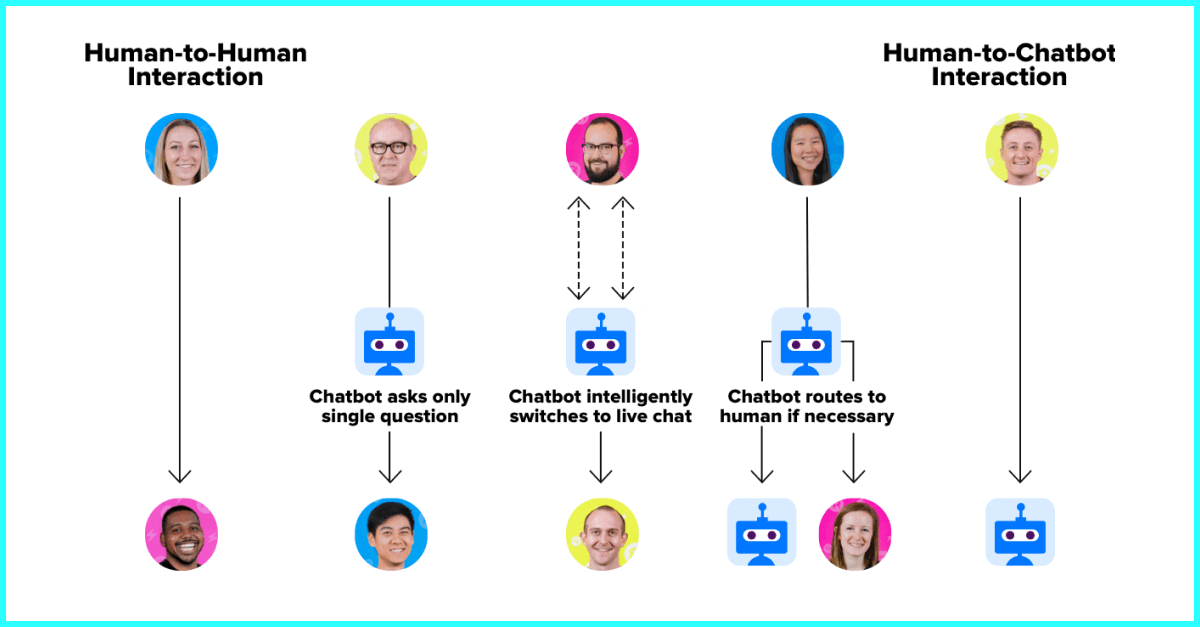
You can get buyers to come to you by providing a variety of ways for them to interact with your business, based on their buying stage, learning style, communication style, etc. You can also offer multiple paths to becoming a lead, such as signing up for a free trial, scheduling a demo, and chatting via live chat.
No matter where their level of interest, you’ll need to provide leads with content relevant to them. For example, when a site visitor is reading content on chatbots, we use our own chatbot to encourage them to test out what a chatbot might look like on their own website through our Test Drive.

Meanwhile, our chatbot for content on account-based marketing offers resources specific to ABM like The Art of ABM ebook. These sorts of tailored sequences make it super easy for interested buyers to become leads and get the information they need to be ready to buy.
3. Qualify
Now it’s time to qualify the leads that come from step two. At this stage, companies will apply their PQL, SQL, and MQL criteria to make sure that leads are worth nurturing hands-on.
You qualification criteria may be different for each source. For example, a lead from a chatbot might need to be enriched and qualified by looking into company headcount and industry. Meanwhile, a PQL that has heavily used the free version of your software might be considered a high-quality lead because of their usage, even if they don’t satisfy the normal requirements for other types of leads.
However you qualify leads, do it quickly. During the buying process, B2B buyers prioritize quick, expert answers to their questions over everything else.

To qualify and respond to buyers faster, you could automate your PQL qualification and nurturing or try Drift Fastlane to qualify buyers immediately through your lead forms and connect them to sales for faster service.
4. Nurture
Now it’s time to nurture those leads. Targeted content is the most essential element of lead nurturing. Great content can help with both one-on-one nurturing and automated nurturing by providing helpful resources that educate and inform rather than drive a hard sell.
In order to use your time wisely while engaging all your leads, you’ll need to treat qualified leads and unqualified leads differently.
- Qualified Leads: For qualified leads, make sure to follow up via email to schedule calls and chat directly with leads when they visit your website (for easy and instant target account engagement). It’s important to respond to that lead’s individual demands. For example, some leads might prefer to be given resources and time to read them alone, while others would rather get on a call for quick questions. Lead scoring can help sellers determine the right approach for each qualified lead.
- Unqualified Leads: While you’ll spend the majority of your efforts and resources on qualified leads, it’s important to nurture unqualified ones as well — so that your business stays top of mind. You can divert unqualified leads towards automated nurturing sequences so that if the lead becomes qualified, they still remember your company and want to work with you over anyone else.
Throughout all of this, make sure to use a customer relationship management software (CRM) to track all interactions and follow-ups.
5. Close
Depending on the product or service being offered, the closing process may require a single call and a signed contract or multiple presentations with stakeholders, a detailed proposal, a security questionnaire, and service level agreements.
In short, how you close the deal will depend largely on your buyer. If you’re not sure how to approach it, check out our top 14 sales closing techniques.

6. Delight
Even after the lead has become a closed-won deal, the process still isn’t complete. To turn that customer into an advocate who will refer others to your business, you need to exceed the promises made during the sales process.
Delighting customers is all about excellent delivery of services. For software companies, this might look like excellent implementation and staff training. For home services professionals, it might be the quality of the work done and the proactiveness of the communication.
10 Best Lead Generation Marketing Strategies
Considering that only a fraction of leads turn into deals, you need significantly more leads to get the number of new customers that you want in a month or quarter.
So, how do you generate leads?
Done right, these strategies and channels can drive thousands of leads per month.
1. Cold Calling Lead Generation
To grow your business, you can’t just wait for the perfect leads to come to you.
Cold calling is a very popular method for lead generation in outbound sales. In most B2B organizations, sales development representatives (SDRs) manage cold calling to book new opportunities and fill the pipeline for account executives (AEs) who will take over once the prospect responds positively to the call and becomes a lead.
To get better results with your cold calling, try a funny sales opening line like, “This is a prospecting call. Want to hang up or can I have 30 seconds?”
2. LinkedIn Lead Generation
LinkedIn offers a lot of different ways to generate leads:
-
- Employee Advocacy and Organic Relationship-Building: Employee advocacy is when employees use their social media platforms to post positive things about your business and drive organic traffic and leads. Here at Drift, we put a ton of work into our LinkedIn presence as a company. We have employee advocates at every level and in every department.

-
- Sales Navigator List Building, Outreach, and Engagement: LinkedIn also offers Sales Navigator, a powerful prospecting tool for finding and engaging with professionals around the world. You can build lists with custom criteria, reach out to prospects with LinkedIn messages, and track the posts of your prospects so you can comment on them to stay top of mind. This allows you to generate leads both in an outbound and semi-inbound way — as you can connect with prospects and then let them come to you after they see your comments and your posts.
- Native Ads with Lead Gen Forms: LinkedIn offers native advertising, which you can use to send traffic to one of your website’s landing pages or to generate leads directly inside of LinkedIn with their lead gen forms. When a lead fills out one of your forms on LinkedIn, their information is automatically populated based on their profile details, making it faster and easier for them to download your content or request a demo.
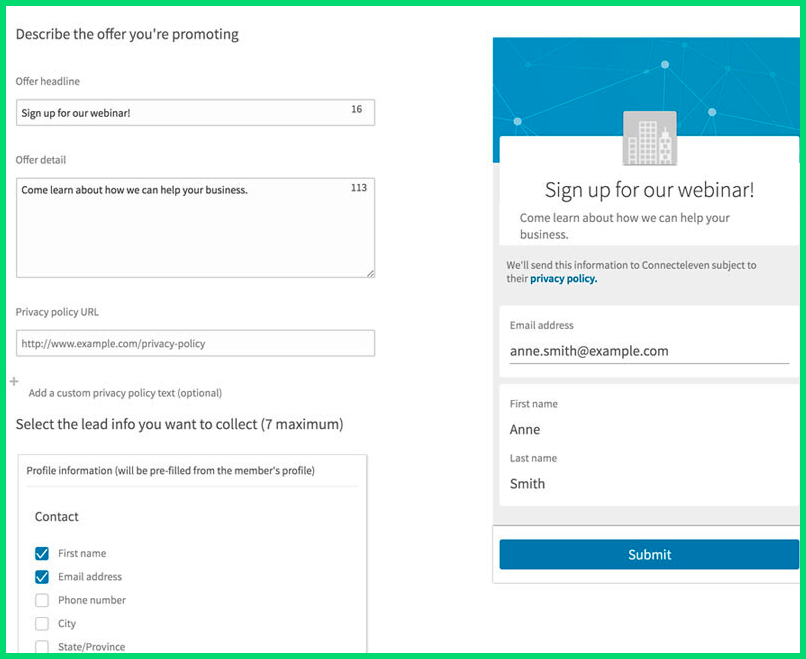
3. Facebook Lead Generation
Facebook, like all social media platforms, also offers the opportunity for both organic and paid lead generation.
There are a few different ways to generate leads with Facebook:
-
- Facebook and Instagram Ads: With Facebook’s advertising platform, you can target Facebook and Instagram users from one place. It’s challenging to use Facebook for organic B2B lead generation since most people only connect with friends and family, so Facebook ads offer a better way to reach the platform’s massive audience.
- Facebook Page Organic Marketing: Any business can use Facebook to create a page and post organically. Facebook is known for offering low reach to business pages, but occasionally your quality content (videos, announcements, special deals, etc.) might get decent views. And of course, you can use Facebook ads to boost your posts to people who like your page or to target audiences.
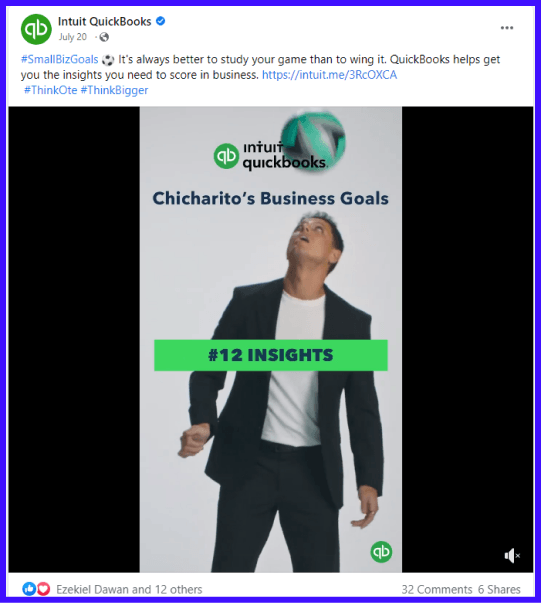
- Facebook Profile Organic Marketing: It’s also possible to generate leads from your personal profile. This is common practice for small business owners, such as interior designers or consultants. Simply upload a profile header relevant to your business, then link to your Facebook business page and website from your profile to start getting more leads. You can connect with locals in your area or friends of friends to grow your organic reach.
- Facebook Groups: Facebook groups are a popular lead generation strategy for businesses of all kinds: B2B SaaS brands, ecommerce companies, consultants, and so on. Make sure to give your group a clear name and useful description so that it shows up when people are searching for the topic. You can generate leads by responding to group members’ questions and posting your best content.
4. SEO Lead Generation
SEO stands for search engine optimization and refers to the practice of creating and optimizing content to rank in search engines — namely Google, which owns 92% of searches globally. SEO is one of the most popular lead generation strategies because it allows you to capture leads that are actively searching for your products and services, or topics adjacent to your products and services (as opposed to watching random videos on YouTube).
SEO is also fantastic for its longevity. A piece of content that addresses the intent of the keywords you target can continue to rank indefinitely, attracting traffic and, if optimized properly, contributing to lead generation.
According to HubSpot’s 2022 State of Marketing Trends Report, B2B brands are more likely to see ROI from SEO than B2C brands. One theory on why B2B businesses continue to invest in SEO is the investment (time, resources, freelancers) is spent once for the creation of the piece, as opposed to paying for each click via PPC ads, which we’ll discuss in the next section. SEO is also an important strategy for local businesses, who can optimize their Google Business profiles to show up in map results.
5. PPC Search Ads Lead Generation
Pay-per-click (PPC) advertising refers to search engine advertising. This is a great lead generation strategy for businesses that aren’t yet showing up in organic search results or that want to make sure they’re always competing for the most popular terms related to their business.
Google search ads allow you to include featured snippets and links so that searchers can click on what interests them the most.

This way, you’re instantly catering to your prospects’ needs and converting more people into leads than if you were to send everyone to the same page.
6. Affiliates and Partnerships Lead Generation
Businesses of all sorts can generate leads through partnerships.
Here are some of the most common ways:
- Referral Partnerships: You can swap referrals with businesses that offer complimentary services and products.
- Content Partnerships: You can create content in partnership with brands that serve similar customers in order to reach each others’ audiences.
- Affiliate Programs: You can set up an affiliate program so that affiliates are paid per lead or paid per transaction.
Check out our own Drift Partner Program to see all the amazing businesses we’ve forged close relationships with.
7. Event Lead Generation
There are so many different ways to generate leads with events. Companies can host their own in-person or virtual events, such as conferences, summits, and panel discussions. Or, they can attend or sponsor an event in the hopes of driving awareness, traffic, and leads.
When running events to generate demand, the most important thing is your content. Spend time learning about the biggest problems your audience is facing and build your event content around them. If your content is too basic or beginner, your conversion and attendance rates will suffer. At our FLASH event, we focused our content around topics that would draw buyer interest like conversion intelligence, brand in the digital-first world, personalized experiences, and more.
And, if you want to scale back a little and run these kinds of events more often, you can also host virtual webinars on topics ranging from thought leadership content to live product demos.
8. Cold Email Lead Generation
Cold email refers to emails sent to prospects without their request. You’re essentially reaching out and hoping they’ll reply.
We’ve all received cold emails done wrong (no personalization, no relevance, too long, etc.) — and you’d hate for your prospects to feel the same. To get it right, make sure you include how you found out about the prospect, why you’re contacting them, and how you can help. If you’re not sure where to start with your email, check out these tried-and-true cold email templates.
And make sure to never buy lead lists. Instead, build your lists manually with tools that help you better identify and target buyers like Sales Navigator and Drift Prospector to make sure each prospect is really a fit for your business. Otherwise, you’ll just be wasting time contacting low-quality leads.
9. Email Marketing Lead Generation
Email marketing, on the other hand, refers to emails sent to people who opted into your marketing lists. They may have signed up for your newsletter or downloaded a report from your website.
You can use email marketing to:
- Re-engage cold leads
- Convert email subscribers into leads
- Get sign-ups for your free tools, content, events, etc.
- Stay top of mind with unqualified leads with the potential to become a qualified lead in the future

10. Twitter Lead Generation
Twitter is often used by professionals who want to build their personal brands. That makes it a great platform for B2B businesses to drive leads.
For example, Ahrefs — a SEO software company — has over 115,000 followers. They use their account to post about platform updates and SEO best practices. In this example post, they’re spreading the word about their free tools in order to generate more free users and ultimately more PQLs.
Expand Your Lead Generation Strategy with Drift
The way that you generate, qualify, and nurture leads has the power to fill your sales team’s pipeline and win over customers. But if you don’t get it right, you might end up frustrating everyone involved.
If you want your lead generation initiatives to succeed, you need to remove any and all friction between you and prospective customers, and deliver a buyer and customer experience that addresses needs as soon as possible.
That’s where Drift can help.
Drift Conversation Cloud is a conversational platform that unifies your marketing, sales and service teams so you can deliver personalized experiences at every stage of the buyer and customer journey to drive more quality pipeline, revenue, and happier customers. Get a demo today.
